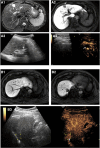A comparative study of gadolinium-ethoxybenzyl-diethylenetriamine pentaacetic acid-enhanced magnetic resonance imaging and contrast-enhanced ultrasound in the detection of intrahepatic lesion
- PMID: 36086711
- PMCID: PMC10980474
- DOI: 10.1097/MD.0000000000030482
A comparative study of gadolinium-ethoxybenzyl-diethylenetriamine pentaacetic acid-enhanced magnetic resonance imaging and contrast-enhanced ultrasound in the detection of intrahepatic lesion
Abstract
We evaluated the diagnostic performance of both gadolinium-ethoxybenzyl-diethylenetriamine pentaacetic acid-enhanced magnetic resonance imaging (Gd-EOB-DTPA-MRI) and contrast-enhanced ultrasound (CEUS) for focal liver lesions, especially for the detection of small (<2 cm) intrahepatic lesions. We retrospectively reviewed patients who underwent Gd-EOB-DTPA-MRI and CEUS before liver resection and compared Gd-EOB-DTPA-MRI and CEUS in the detection of focal liver lesions. A total of 216 patients were included, and 309 lesions were found. The sensitivity values of MRI and CEUS for the main lesion were both more than 95%, and the coincidence rates were both more than 80%. Regarding lesions <2 cm, 135 such lesions were detected by MRI, whereas only 85 were detected by CEUS. For lesions <2 cm, the sensitivity, specificity, and coincidence rates of MRI were significantly better than those of CEUS. Among 27 patients, 50 more lesions were detected by MRI than CEUS, 56% (28/50) of which were malignant. For the large lesion, the diagnostic performance is similar between Gd-EOB-DTPA-MRI and CEUS, and the sensitivity and coincidence rates of both methods are high. Gd-EOB-DTPA-MRI is likely to detect small (<2 cm) focal intrahepatic lesions.
Copyright © 2022 the Author(s). Published by Wolters Kluwer Health, Inc.
Conflict of interest statement
The authors have no conflicts of interest to disclose.
Figures


Similar articles
-
Comparison of Contrast-Enhanced Ultrasound and Gadolinium-Ethoxybenzyl-Diethylenetriamine Pentaacetic Acid-Enhanced MRI for the Diagnosis of Macroscopic Type of Hepatocellular Carcinoma.Dig Dis. 2016;34(6):679-686. doi: 10.1159/000448855. Epub 2016 Oct 17. Dig Dis. 2016. PMID: 27750237
-
Usefulness of combining gadolinium-ethoxybenzyl-diethylenetriamine pentaacetic acid-enhanced magnetic resonance imaging and contrast-enhanced ultrasound for diagnosing the macroscopic classification of small hepatocellular carcinoma.Eur Radiol. 2015 Nov;25(11):3272-81. doi: 10.1007/s00330-015-3725-0. Epub 2015 Jun 3. Eur Radiol. 2015. PMID: 26037713
-
Value of retrospective fusion of PET and MR images in detection of hepatic metastases: comparison with 18F-FDG PET/CT and Gd-EOB-DTPA-enhanced MRI.J Nucl Med. 2010 May;51(5):692-9. doi: 10.2967/jnumed.109.068510. Epub 2010 Apr 15. J Nucl Med. 2010. PMID: 20395324
-
[Application of Diffusion-Weighted Imaging and Hepatobiliary-Specific Contrast Agent Gd-EOB-DTPA in the Diagnosis and Differential Diagnosis of Focal Liver Lesions].Sichuan Da Xue Xue Bao Yi Xue Ban. 2022 Sep;53(5):737-743. doi: 10.12182/20220960205. Sichuan Da Xue Xue Bao Yi Xue Ban. 2022. PMID: 36224672 Free PMC article. Review. Chinese.
-
Enhancements in hepatobiliary imaging: the spectrum of gadolinium-ethoxybenzyl diethylenetriaminepentaacetic acid usages in hepatobiliary magnetic resonance imaging.Abdom Radiol (NY). 2016 Sep;41(9):1825-41. doi: 10.1007/s00261-016-0767-y. Abdom Radiol (NY). 2016. PMID: 27225503 Review.
References
-
- Battaglia V, Cervelli R. Liver investigations: updating on US technique and contrast-enhanced ultrasound (CEUS). Eur J Radiol. 2017;96:65–73. - PubMed
-
- Heimbach JK, Kulik LM, Finn RS, et al. . AASLD guidelines for the treatment of hepatocellular carcinoma. Hepatology. 2018;67:358–80. - PubMed
-
- Pascolo L, Cupelli F, Anelli PL, et al. . Molecular mechanisms for the hepatic uptake of magnetic resonance imaging contrast agents. Biochem Biophys Res Commun. 1999;257:746–52. - PubMed
-
- Son J, Hwang SH, Park S, et al. . Imaging features of hepatocellular carcinoma: quantitative and qualitative comparison between MRI-enhanced with Gd-EOB-DTPA and Gd-DTPA. Invest Radiol. 2019;54:494–9. - PubMed
MeSH terms
Substances
LinkOut - more resources
Full Text Sources
Medical

